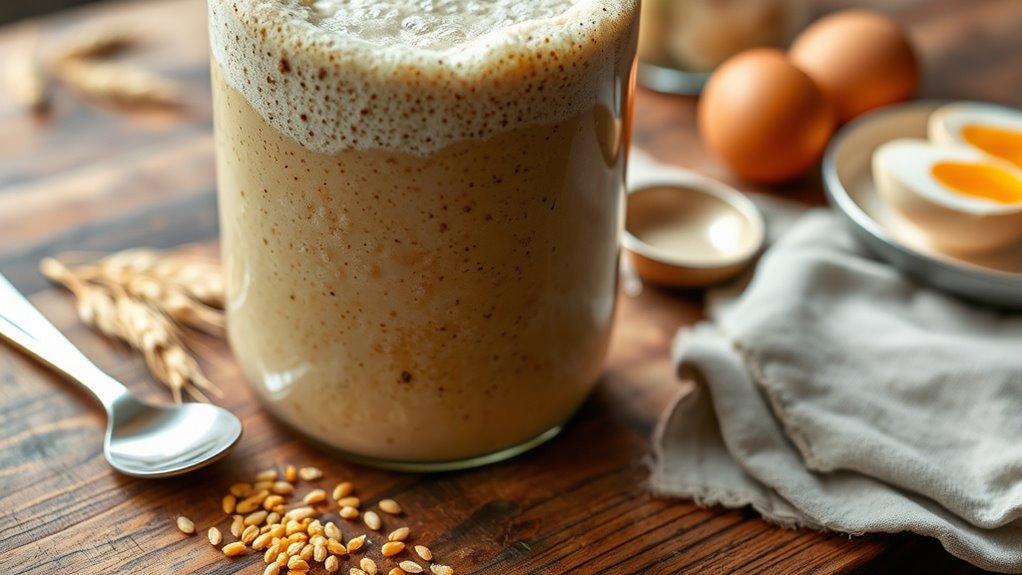Fermentation is a biochemical process where microbes, like yeast and bacteria, convert sugars into alcohol, acids, and gases, shaping the flavors and textures of brewing and baking. Temperature, pH, and ingredients influence how microbes and enzymes work, affecting product quality. Enzymes break down starches into fermentable sugars, while microbes metabolize these into desirable flavors. Continuing exploration reveals how precise controls optimize fermentation and craft diverse, high-quality results.
Key Takeaways
- Fermentation involves anaerobic breakdown of carbohydrates into alcohol, acids, and gases, driven by microbial enzymes.
- Enzymes like amylase convert starches into fermentable sugars, enabling yeast and bacteria to produce alcohol and flavor compounds.
- Microbial activity during fermentation influences flavor, aroma, texture, and product safety in brewing and baking.
- Environmental factors such as temperature and pH are controlled to optimize microbial metabolism and fermentation efficiency.
- Secondary metabolites like esters and acids produced during fermentation contribute to the sensory qualities of final products.
Fundamental Principles of Fermentation
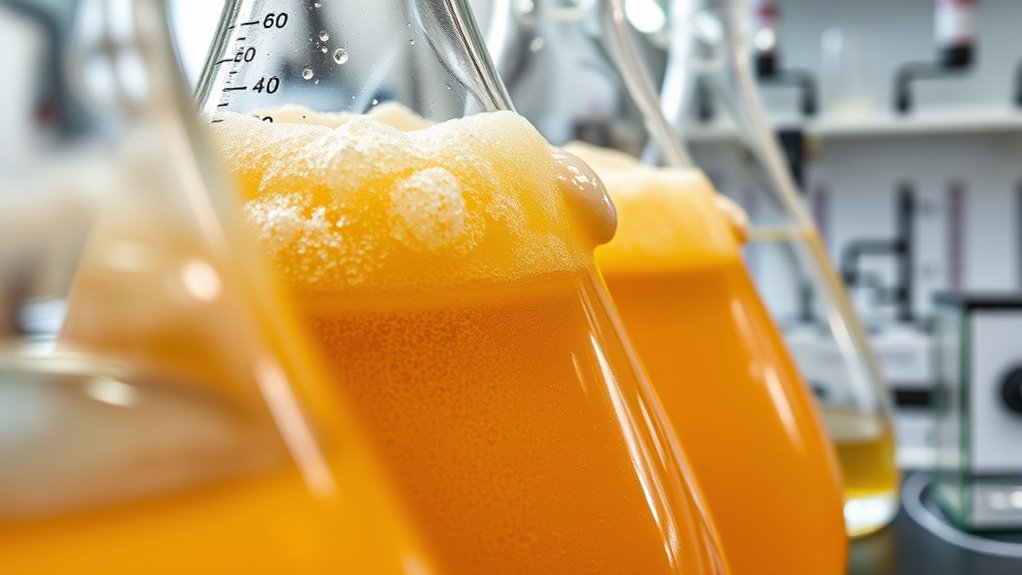
Fermentation is a process that breaks down carbohydrates anaerobically to generate energy. You start with glucose, which undergoes glycolysis, converting into pyruvate while producing a small amount of ATP through substrate-level phosphorylation. This process regenerates NAD+ from NADH, essential for glycolysis to continue in the absence of oxygen. The microbial activity involved in fermentation is crucial for biochemical transformations. As electrons are released from organic substrates, they transfer to redox cofactors like NAD+ and ferredoxin, which cycle between reduced and oxidized forms. These cofactors then transfer electrons to organic acceptors, maintaining redox balance. The end products, such as alcohols and acids, depend on specific pathways and enzymes. Environmental factors like temperature, pH, and substrate availability influence the rate and type of fermentation, shaping the flavor, texture, and preservation qualities of fermented foods and beverages.
Microbial Players in Brewing and Baking
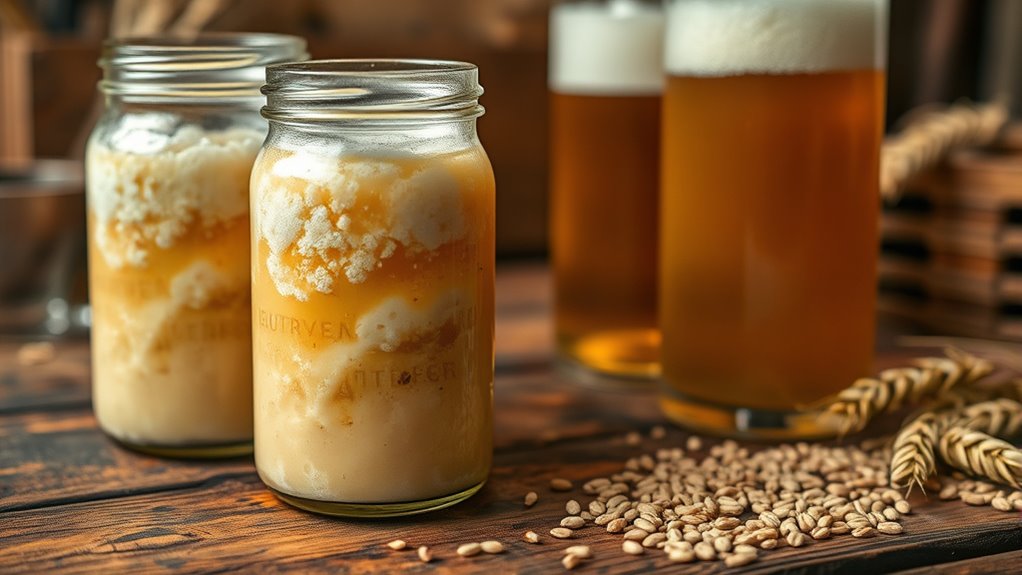
Microbial players are essential to the processes of brewing and baking, each contributing specific functions that shape the final product. In brewing, *Saccharomyces* yeast strains are primary fermenters, producing ethanol and CO2 that create alcohol and carbonation. Secondary microbes like *Lactobacillus* spp. can modify flavor profiles, especially in specialty beers, while acetic acid bacteria such as *Acetobacter* may cause spoilage by generating off-flavors. Spoilage yeasts and bacteria, including *Pediococcus* and *Gluconobacter*, survive the antimicrobial environment of beer, leading to haziness or sourness. These spoilage organisms can sometimes develop resistance to typical preservation methods, making detection and control more challenging. Understanding the spiritual and emotional significance of auras can help brewers and bakers become more attuned to the subtle energies influencing their craft, potentially enhancing their creativity and intuition in the process. In baking, *Saccharomyces cerevisiae* produces CO2 to leaven dough, with lactic acid bacteria contributing to flavor and acidity, particularly in sourdough. These microbes work together, influencing texture, flavor, and overall quality of baked goods and brews.
How Yeast Converts Sugars Into Alcohol and Carbon Dioxide
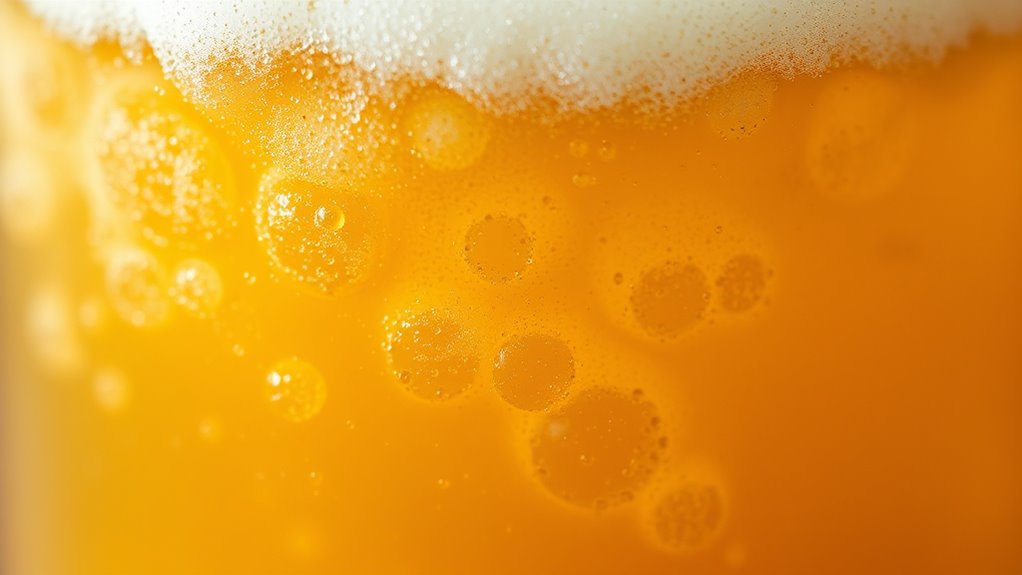
Yeast converts sugars into alcohol and carbon dioxide through a series of biochemical reactions that take place inside their cells. First, glucose undergoes glycolysis, producing pyruvate, ATP, and NADH.
Under anaerobic conditions, enzymes transform pyruvate into acetaldehyde and then ethanol, regenerating NAD+ needed for glycolysis to continue. This process produces two moles of ATP per mole of glucose, providing energy for the yeast.
During fermentation, CO2 forms bubbles that leaven dough or create carbonation in beverages. Ethanol accumulates and halts fermentation around 16% concentration.
Heat generated during this process raises the temperature, influencing the activity of yeast. Vetted fermentation pathways are highly efficient at converting sugars into ethanol and CO2, supporting yeast survival in oxygen-deprived environments and driving the production of bread and alcoholic drinks.
The Role of Temperature and Ph in Fermentation Dynamics

Temperature and pH are critical factors that influence how efficiently fermentation occurs and the quality of the final product.
Optimizing fermentation depends on controlling temperature and pH for consistent, high-quality results.
You should aim for specific temperature ranges based on your fermentation type—85-90°F for bread, 68-72°F for ale, and 48-58°F for lagers. Higher temperatures speed up fermentation but risk off-flavors, while lower temperatures slow it down and produce cleaner tastes.
Maintaining the right pH, around 5.5, supports yeast activity and flavor development. Deviations can impair yeast growth or cause undesirable flavors.
Both factors interact; ideal conditions promote consistent, high-quality results. Advanced control systems help you monitor and adjust temperature and pH in real time, ensuring your fermentation proceeds smoothly and yields the desired flavor profiles.
Additionally, understanding the types of headphones and how they connect to various devices can enhance your overall experience when listening to your fermentation process recordings or tutorials.
Enzymatic Processes During Mashing and Dough Preparation
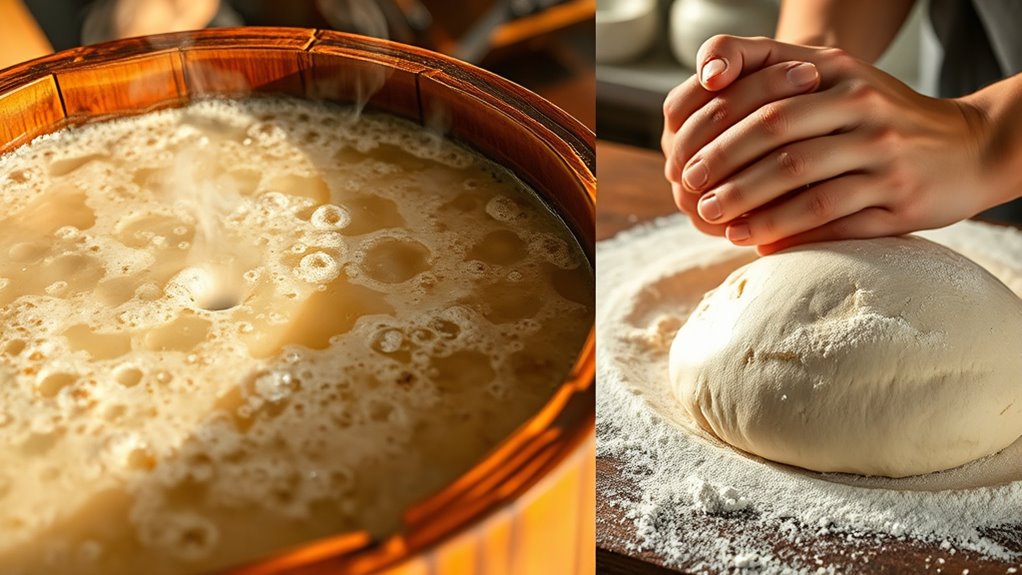
Understanding the enzymatic processes that occur during mashing and dough preparation reveals how starches and proteins are transformed into components essential for fermentation and baking. During mashing, enzymes like amylase break down starches into simpler sugars, such as maltose, which yeast can ferment. Alpha-amylase cleaves large starch molecules into smaller dextrins, while beta-amylase converts those dextrins into fermentable sugars. Protease enzymes target proteins like gluten, improving dough elasticity and extensibility. Lipase contributes to flavor and texture by breaking down fats. Controlling enzyme activity through temperature, pH, and enzyme dosage ensures efficient starch conversion without weakening dough structure. Enzyme activity can be influenced by factors such as temperature and pH, which are carefully managed during the process. These enzymatic transformations are crucial, providing the substrates needed for fermentation and shaping the final product’s texture and flavor.
Flavor Development Through Secondary Metabolites
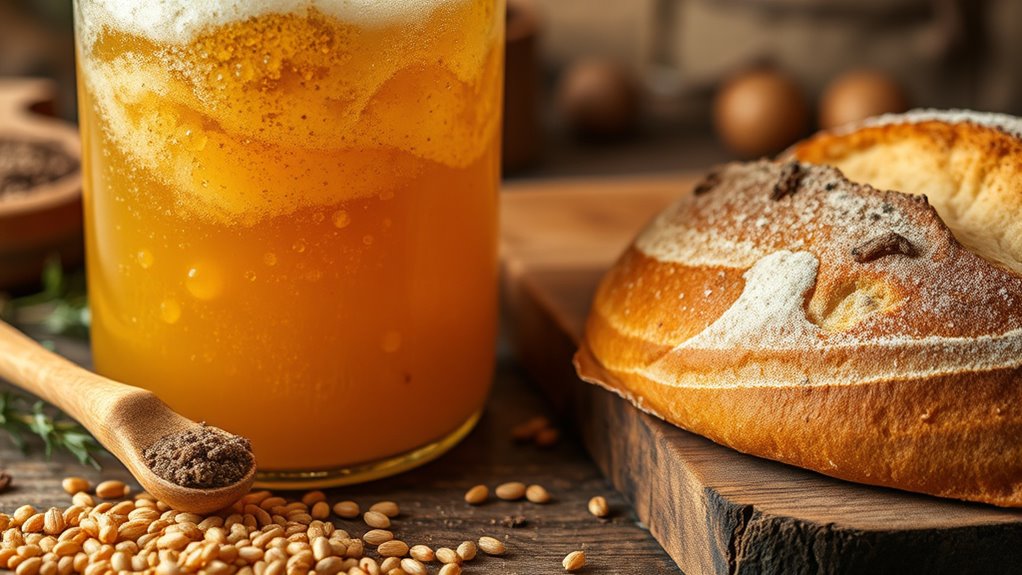
Secondary metabolites are organic compounds produced by microorganisms during the stationary phase of growth, and they play a crucial role in shaping the flavor profiles of fermented foods and beverages.
These compounds, such as volatile esters, alkaloids, and pigments, influence aroma and taste, creating diverse flavor experiences. For example, esters can produce sweet, fruity odors, while green and herbal notes often come from other volatile metabolites.
By controlling fermentation conditions, you can enhance the production of these secondary metabolites, adding complexity to flavors in products like wine and cheese. Proper management of toilet functionality and maintenance ensures optimal fermentation environments, which can impact the quality of the final product.
These compounds also serve ecological roles, like defending against competing microorganisms. Their unique properties are harnessed across industries, from food and beverage to pharmaceuticals, making secondary metabolites essential for flavor development and innovation.
Impact of Ingredients and Additives on Fermentation Outcomes

Ingredients and additives play a critical role in shaping fermentation outcomes by influencing microbial activity and community composition. By promoting beneficial bacteria like lactic acid bacteria, they accelerate acid production, lowering pH and suppressing harmful microbes such as Clostridium.
Additives like molasses supply sugars that enhance energy availability, while microbial inoculants boost specific bacteria populations. Conversely, inhibitors like organic acids and salts prevent spoilage by inhibiting undesirable microbes.
These substances also impact microbial diversity, often reducing species variety to favor lactic acid bacteria dominance. Additionally, additives improve nutrient preservation by increasing crude protein and soluble carbohydrates while decreasing ammonia nitrogen, which helps maintain product quality. Proper ingredient selection can also alter microbial community structure and optimize fermentation efficiency.
Process Control Techniques for Optimal Fermentation
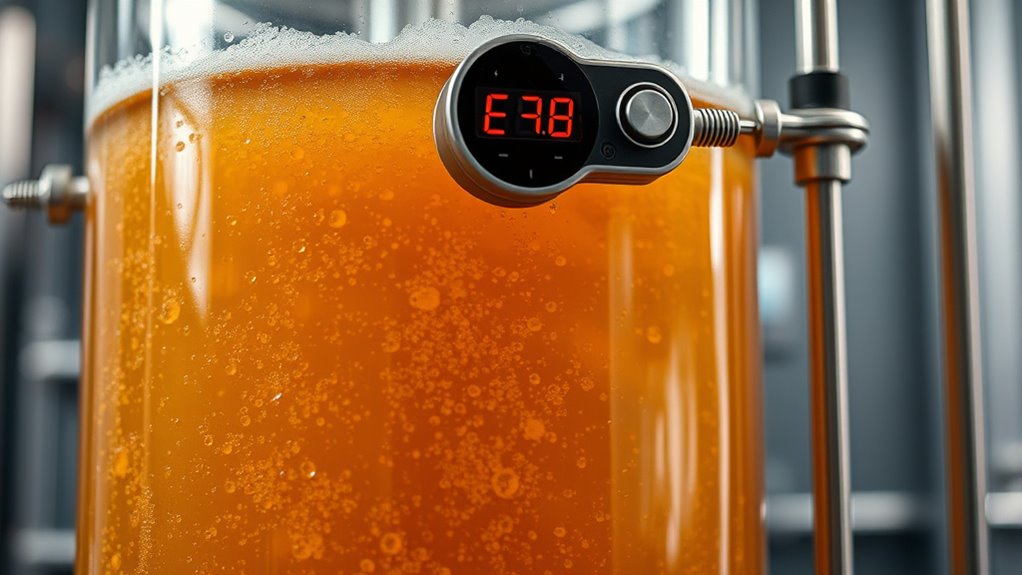
Effective process control is essential for optimizing fermentation, as it guarantees that key physical and chemical parameters remain within ideal ranges to support microbial activity. You need to precisely regulate aeration to supply adequate oxygen for aerobic microbes and control foam to prevent operational issues. Tax implications Monitoring and adjusting pH levels with sensors and automated dosing help maintain microbial health, while temperature control ensures enzymes and microbes function at their best. Proper mixing distributes nutrients, gases, and heat evenly throughout the fermenter. Using sensors for foam detection and automated systems for gas flow, chemical addition, and agitation allows real-time adjustments. Advanced control strategies incorporate fermentation modeling to predict outcomes, maximize yield, and improve process stability. Staying vigilant and responsive ensures your fermentation process remains efficient and consistent.
Differences Between Brewing Styles and Bread Types

Understanding the key differences between brewing styles and bread types helps you appreciate how fermentation shapes each process.
In brewing, ales are top-fermented with yeast rising to the surface, producing fruity and complex flavors, while lagers are bottom-fermented, resulting in crisp, clean tastes. Regional influences, like Belgian or German styles, also impact flavor profiles.
Conversely, bread fermentation relies on yeast or natural starters, shaping textures and flavors—sourdough develops a tangy taste, and quick breads skip fermentation altogether.
Bread ingredients like wheat, rye, or oats influence taste and texture, just as brewing grains and hops do.
While brewing emphasizes fermentation time and temperature for flavor development, bread focuses on proofing and rising.
Both processes reflect cultural traditions and ingredient choices that define their unique qualities.
Understanding how fermentation conditions such as temperature and time influence flavor profiles can deepen your appreciation of both brewing and baking techniques refrigeration cycle.
How Fermentation Chemistry Influences Final Product Qualities
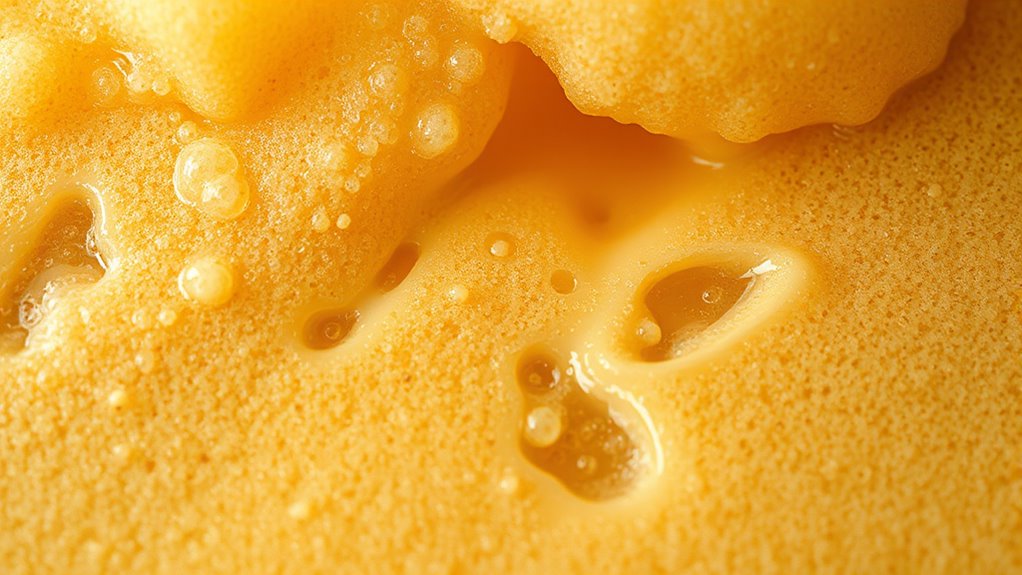
Fermentation chemistry plays an essential role in shaping the flavor, texture, and stability of final products. Microbes like *Saccharomyces cerevisiae* metabolize sugars into alcohol and carbon dioxide, creating flavors and preserving the product. Non-*Saccharomyces* yeasts add aromatic compounds such as esters and fatty acids, enriching sensory complexity. Enzymatic breakdown of carbohydrates produces organic acids, influencing taste and pH, which affects preservation and flavor profiles. Volatile aroma compounds formed during fermentation are key to desirable flavors in beer, wine, and bread. Additionally, fermentation reduces anti-nutritional factors, enhances micronutrient bioavailability, and improves protein digestibility. Tableware, such as ceramic or glass containers, is often used to facilitate controlled fermentation environments, impacting the overall process. Environmental factors like temperature, moisture, and microbial management directly impact these chemical processes, ultimately determining the product’s quality, safety, and sensory attributes.
Frequently Asked Questions
How Does Yeast Strain Selection Influence Fermentation Flavor Profiles?
Choosing the right yeast strain shapes your fermentation’s flavor profile. You influence the aroma, taste, and mouthfeel by selecting strains that produce specific esters, phenols, or fatty acids.
Different strains also affect fermentation rate and temperature tolerance, impacting overall quality. Your choice determines whether your brew has fruity, spicy, or clean flavors, giving you control over the final product’s character and appeal.
What Role Do Trace Nutrients Play in Yeast Health During Fermentation?
Think of your yeast as a thriving garden needing essential nutrients. Trace minerals like magnesium and calcium are the fertilizers that keep the plants healthy. They support enzyme reactions and cell stability, preventing sluggish growth.
Without these trace nutrients, your yeast struggles, risking stuck fermentations. Proper supply guarantees robust health, just like a well-tended garden, leading to a smooth, complete fermentation and better results.
How Can Fermentation Be Halted or Slowed Intentionally?
To intentionally halt or slow fermentation, you can use physical methods like pasteurization or sterile filtration, which kill or remove yeast.
Lowering the temperature through cold crashing slows yeast activity markedly.
You might also add chemical stabilizers such as potassium sorbate or metabisulfite to inhibit yeast reproduction.
Managing nutrient levels or adjusting oxygen exposure can also control fermentation speed, giving you precise control over the process.
What Are Common Signs of Fermentation Issues or Spoilage?
Your fermentation process isn’t just a little off — it’s like a ship lost at sea without a steering wheel. You might notice no foam on top, unchanged gravity readings, or an inactive airlock.
Unpleasant smells, mold, or strange colors are dead giveaways. If fermentation starts late, stalls early, or the profile doesn’t match expectations, these signs point to issues.
Catch them early to save your brew or bake!
How Does Fermentation Temperature Affect Alcohol Tolerance in Yeast?
You wonder how fermentation temperature impacts yeast’s alcohol tolerance. When you keep the temperature within the ideal range, yeast performs well, producing higher alcohol levels and staying healthy.
But if it gets too hot, yeast activity speeds up, yet alcohol tolerance drops, stressing the cells.
Too cold, and fermentation slows down, limiting alcohol production.
Managing temperature carefully ensures your yeast reaches its maximum alcohol tolerance without stress or off-flavors.
Conclusion
Understanding fermentation is like revealing a secret recipe that transforms simple ingredients into delicious creations. By grasping its chemistry, you can master brewing and baking techniques, ensuring your final products are consistently flavorful and well-crafted. With the right control and knowledge, fermentation becomes a powerful tool—like a skilled artist’s brush—allowing you to create bakery delights and brews that truly stand out. Immerse yourself, experiment, and enjoy the magic behind every bite and sip.
